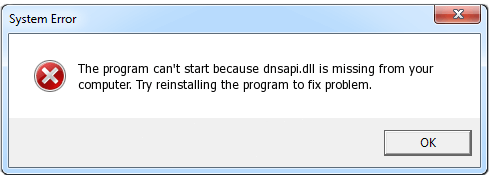This article is dedicated to helping users remove Trojan Patched.AO and fix the DNSAPI.dll missing error, which may be connected to the trojan virus family, as users commonly refer to them. The DNSAPI.dll Missing Error can also be displayed on its own, but much of the time it is “broken” by the trojan in question.
WARNING!
Again, if you are here for the dnsapi.dll missing error, this may be related to a trojan virus called Win32/Patched.AO. The removal guide will provide solutions for both the error and the virus, if there is one.
Despite being predominantly called Viruses by most users, in reality Trojans are not, as surprising as this sounds. They are still very much malicious and dangerous, but the fine distinction between viruses and malware is that viruses can replicate and regenerate themselves even if you delete them. They have in-built capabilities to do so. Trojan Win32/Patched.AO and DNSAPI.dll Missing Error can not. Facts point that if you manage to remove them once, they will not come back to bother you again. That is why there is an entirely different classification called “malware” and this is the one the trojan belongs to.
What is a Trojan?
The simplest explanation is the classical one. Just as the famous trojan horse it was named after, this type of malware serves as a front or back door, depending how you look at it. They basically get in and leak information to whoever created them, as well as serve as a weak point in the security system of your computer. If a Trojan is associated with another virus it can help that virus install itself on your machine without your authorization or knowledge. Hackers who create Trojans are often paid by hackers who make other viruses in order to use the network of infected computers to distribute their malicious work.
How does DNSAPI.dll Missing Error factor in the work of the Trojan?
The DNSAPI.dll file is a library file used by Windows in task related to internet access and for this reason it is often targeted by threats like Trojan Win32/Patched.AO. It is used by Window’s DNS Client API and if it has been tampered with or corrupted Windows cannot process the settings inside, thus causing a variety of DNS Client error files to pop up. A list of these errors include:
- This application failed to start because DNSAPI.DLL was not found. Re-installing the application may fix this problem.
- Dnsapi.dll not found.
- The file Dnsapi.dll is missing.
- Dnsapi.dll Access Violation.
- Cannot register dnsapi.dll.
- Cannot find C:WindowsSystem32\dnsapi.dll.
These errors will most often pop during start-up after a system power-on/reboot, but they can also appear when another program on your computer tries to access Dnsapi.dll. These errors are a sure sign you have a serious Trojan-related problem.
DO NOT try to simply replace Dnsapi.dll on your computer without dealing with the Trojan! It will remain installed on your compter and also there are many fake sites that offer manipulated .dll files. Even if the error disappears it could be because the .dll file is written more cleverly and Windows cannot recognize that the file is not the original one.
If you are seeing any of these errors on your computer then you must take adequate action against Trojan Win32/Patched.AO. The fact that Dnsapi.dll has been changed renders your computer vulnerable and also makes any firewall you have impotent in adequately dealing with attempts to install viruses on your computer. The more you wait the greater the chances you will have a bigger collection of other threats to deal with.
SUMMARY:
| Name | Patched.AO and DNSAPI.dll |
| Type | Potentially Unwanted Programs and Files |
| Detection Tool |
Some threats reinstall themselves if you don’t delete their core files. We recommend downloading SpyHunter to remove harmful programs for you. This may save you hours and ensure you don’t harm your system by deleting the wrong files. |
Remove Patched.AO and DNSAPI.dll
Search Marquis is a high-profile hijacker – you might want to see if you’re not infected with it as well.


Leave a Reply